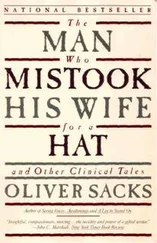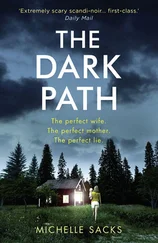Sometimes the hallucinations of Charles Bonnet syndrome can inspire. Virginia Hamilton Adair wrote poetry as a young woman, publishing in the Atlantic Monthly and the New Republic . She continued to write poems during her career as a scholar and professor of English in California, but these, for the most part, remained unpublished. It was not until she was eighty-three and completely blind from glaucoma that she published her first book of poetry, the acclaimed Ants on the Melon . Two further collections followed, and in these new poems she made frequent reference to the Charles Bonnet hallucinations that now visited her regularly, the visions given to her by “the angel of hallucinations,” as she put it.
Adair and, later, her editor sent me extracts from the journal she kept in the last years of her life. They were full of descriptions she dictated of her hallucinations as they occurred, including this:
I am maneuvered into a delightfully soft chair. I sink, submerged as usual in shades of night … the sea of clouds at my feet clears, revealing a field of grain, and standing about it a small flock of fowl, not two alike, in somber plumage: a miniature peacock, very slender, with its little crest and unfurled tail feathers, some plumper specimens, and a shore bird on long stems, etc. Now it appears that several are wearing shoes, and among them a bird with four feet. One expects more color among a flock of birds, even in the hallucinations of the blind.… The birds have turned into little men and women in medieval attire, all strolling away from me. I see only their backs, short tunics, tights or leggings, shawls or kerchiefs.… Opening my eyes on the smoke screen of my room I am treated to stabs of sapphire, bags of rubies scattering across the night, a legless vaquero in a checked shirt stuck on the back of a small steer, bucking, the orange velvet head of a bear decapitated, poor thing, by the guard of the Yellowstone Hotel garbage pit. The familiar milkman invaded the scene in his azure cart with the golden horse; he joined us a few days ago out of some forgotten book of nursery rhymes or the back of a Depression cereal box.… But the magic lantern show of colored oddities has faded and I am back in black-wall country without form or substance … where I landed as the lights went out.
2. The Prisoner’s Cinema: Sensory Deprivation
The brain needs not only perceptual input but perceptual change , and the absence of change may cause not only lapses of arousal and attention but perceptual aberrations as well. Whether darkness and solitude is sought out by holy men in caves or forced upon prisoners in lightless dungeons, the deprivation of normal visual input can stimulate the inner eye instead, producing dreams, vivid imaginings, or hallucinations. There is even a special term for the trains of brilliantly colored and varied hallucinations which come to console or torment those kept in isolation or darkness: “the prisoner’s cinema.”
Total visual deprivation is not necessary to produce hallucinations — visual monotony can have much the same effect. Thus sailors have long reported seeing things (and perhaps hearing them, too) when they spent days gazing at a becalmed sea. It is similar for travelers riding across a featureless desert or polar explorers in a vast, unvarying icescape. Soon after World War II, such visions were recognized as a special hazard for high-altitude pilots flying for hours in an empty sky, and it is a danger for long-distance truckers focused for hours on an endless road. Pilots and truckers, those who monitor radar screens for hours on end — anyone with a visually monotonous task is susceptible to hallucinations. (Similarly, auditory monotony may lead to auditory hallucinations.)
In the early 1950s, researchers in Donald Hebb’s laboratory at McGill University designed the first experimental study of prolonged perceptual isolation, as they called it (the term “sensory deprivation” became popular later). William Bexton and his colleagues investigated this with fourteen college students immured in soundproof cubicles for several days (except for brief time out for eating and going to the toilet), wearing gloves and cardboard cuffs to reduce tactile sensation and translucent goggles which allowed only a perception of light and dark.
At first the test subjects tended to fall asleep, but then, on awakening, they became bored and craved stimulation — stimulation not available from the impoverished and monotonous environment they were in. And at this point, self-stimulation of various sorts began: mental games, counting, fantasies, and, sooner or later, visual hallucinations — usually a “march” of hallucinations from simple to complex, as Bexton et al. described:
In the simplest form the visual field, with the eyes closed, changed from dark to light colour; next in complexity were dots of light, lines, or simple geometrical patterns. All 14 subjects reported such imagery, and said it was a new experience to them. Still more complex forms consisted in “wall-paper patterns,” reported by 11 subjects, and isolated figures or objects, without background (e.g., a row of little yellow men with black caps on and their mouths open; a German helmet), reported by seven subjects. Finally, there were integrated scenes (e.g., a procession of squirrels with sacks over their shoulders marching “purposefully” across a snow field and out of the field of “vision”; prehistoric animals walking about in the jungle). Three of the 14 subjects reported such scenes, frequently including dreamlike distortions, with the figures often being described as “like cartoons.”
While these images first appeared as if projected onto a flat screen, after a time they became “compellingly three-dimensional” for some of the subjects, and parts of a scene might become inverted or pivot from side to side.
After being initially startled, the subjects tended to find their hallucinations amusing, interesting, or sometimes irritating (“their vividness interfered with sleep”) but without any “meaning.” The hallucinations seemed external, proceeding autonomously, with little relevance or reference to the individual or situation. The hallucinations usually disappeared when the subjects were asked to do complex tasks like multiplying three-figure numbers, but not if they were merely exercising or talking to the researchers. The McGill researchers reported, as many others have, auditory and kinesthetic hallucinations as well as visual ones.
This and subsequent studies aroused enormous interest in the scientific community, and both scientific and popular efforts were made to duplicate the results. In a 1961 paper, John Zubek and his colleagues reported, in addition to hallucination, a change in visual imagery in many of their subjects:
At various intervals … the subjects were asked to imagine or visualize certain familiar scenes, for example, lakes, countryside, the inside of their homes, and so forth. The majority of the subjects reported that the images which they conjured up were of unusual vividness, were usually characterized by bright colours, and had considerable detail. All these subjects were unanimous in their opinion that their images were more vivid than anything they had previously experienced. Several subjects who normally had great difficulty visualizing scenes could now visualize them almost instantly with great vividness.… One subject … could visualize faces of former associates of a few years back with almost picture-like clarity, a thing which he was never able to do previously. This phenomenon usually appeared during the second or third day and, in general, became more pronounced with time.
Such visual heightenings — whether due to disease, deprivation, or drugs — can take the form of enhanced visual imagery or hallucination or both.
Читать дальше












